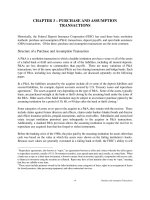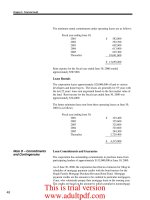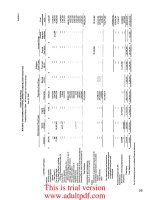Chapter 3 recording transtion
Bạn đang xem bản rút gọn của tài liệu. Xem và tải ngay bản đầy đủ của tài liệu tại đây (498.94 KB, 41 trang )
OPEN UNIVERSITY HCMC
MBA PREPARATORY COURSE
Principles of Financial
Accounting
06/04/16
NGUYEN TAN BINH - PHAN DUC DUNG
1
Chapter 3
Recording
Transactions
06/04/16
NGUYEN TAN BINH - P
2
Learning Objectives
After studying this chapter, you should be able to:
Use double-entry accounting.
Analyze and journalize transactions.
Post journal entries to the ledgers.
Prepare and use a trial balance.
Close revenue and expense accounts and
update retained income.
06/04/16
NGUYEN TAN BINH - P
3
Learning Objectives
After studying this chapter, you should be able to:
Correct erroneous journal entries and describe how errors affect accounts.
Use T-accounts to analyze accounting relationships.
Explain how computers have transformed processing of accounting data.
06/04/16
NGUYEN TAN BINH - P
4
The Double-Entry
Accounting System
Some businesses enter into thousands of transactions daily or even hourly.
Accountants must carefully keep track of and record these transactions in a
systematic manner.
Accountants use a double-entry accounting system in which at least two accounts are always affected by each transaction.
06/04/16
NGUYEN TAN BINH - P
5
The Double-Entry
Accounting System
Each transaction must still be analyzed to determine which accounts are involved, whether the accounts increase or decrease, and how
much the balance will change.
The balance sheet equation can be used for this analysis, but with so many transactions, this is not realistic.
In practice, accountants use ledgers.
06/04/16
NGUYEN TAN BINH - P
6
Ledger Accounts
Ledger - a group of related accounts kept current in a
systematic manner
Think of a ledger as a book with
one page for each account.
The ledger is a company’s “books.”
General ledger - the collection of accounts that
accumulates the amounts reported in the major
financial statements
06/04/16
NGUYEN TAN BINH - P
7
Ledger Accounts
A simplified version of a ledger account is called
the T-account.
They allow us to capture the essence of the accounting process
without having to worry about too many details.
The account is divided into two sides for recording increases and
decreases in the accounts.
Account Title
Left Side
06/04/16
Right Side
NGUYEN TAN BINH - P
8
Ledger Accounts
Balance - difference between total left-side
amounts and total right-side amounts at any
particular time
Assets have left-side balances.
Increased by entries to the left side
Decreased by entries to the right side
Liabilities and Owners’ Equity have right-side balances.
Decreased by entries to the left side
Increased by entries to the right side
06/04/16
NGUYEN TAN BINH - P
9
Ledger Accounts
T-accounts and the balance sheet equation:
Assets = Liabilities + Owners’ Equity
Assets
Increases
Decreases
Liabilities
Decreases
Increases
Owners’ Equity
Decreases
06/04/16
Increases
NGUYEN TAN BINH - P
10
Debits and Credits
Debit (dr.) - an entry or balance on the left side of an account
Credit (cr.) - an entry or balance on the right side of an account
Remember:
Debit is always the left side!
Credit is always the right side!
06/04/16
NGUYEN TAN BINH - P
11
The Recording Process
The sequence of steps in recording transactions:
Transactions
Financial
Statements
06/04/16
Documentation
Journal
Trial
Balance
Ledger
NGUYEN TAN BINH - P
12
The Recording Process
The process starts with source documents, which are the supporting original records of any transaction.
Examples are sales slips or invoices, check stubs, purchase orders,
receiving reports, and cash receipt slips.
06/04/16
NGUYEN TAN BINH - P
13
The Recording Process
In the second step, an analysis of the transaction is placed in the book of original entry, which is a chronological record of how the
transactions affect the balances of applicable accounts.
The most common example is the
general journal a diary of all events
(transactions) in an entity’s life.
06/04/16
NGUYEN TAN BINH - P
14
The Recording Process
In the third step, transactions are entered into the ledger.
Remember that a transaction is not entered in just one place; it
must be entered in each account that it affects.
Depending on the nature of the organization, analysis of the
transactions could occur continuously or periodically.
06/04/16
NGUYEN TAN BINH - P
15
The Recording Process
The fourth step includes the preparation of the trial balance, which is a simple listing of all accounts in the general ledger with
their balances.
Aids in verifying accuracy and
the financial statements
in preparing
Prepared periodically as necessary
06/04/16
NGUYEN TAN BINH - P
16
The Recording Process
In the final step, the financial statements are prepared.
Financial statements are prepared each quarter of the year for
publicly traded companies.
Other companies prepare financial statements at various other
intervals to
meet the needs of
their users.
06/04/16
NGUYEN TAN BINH - P
17
Journalizing Transactions
Journalizing - the process of entering transactions into the journal
Journal entry - an analysis of the effects of a transaction on the accounts, usually accompanied by an explanation of the
transaction
This analysis identifies the accounts to be debited and credited.
06/04/16
NGUYEN TAN BINH - P
18
Journalizing Transactions
The conventional form for journal entries includes the
following:
The date and identification number of the entry
The accounts affected and an explanation of the
transaction
The posting reference, which is the number assigned
to each account affected by the transaction
The amounts that the accounts are to be debited and
credited
06/04/16
NGUYEN TAN BINH - P
19
Journalizing Transactions
The conventional form for recording in the general journal:
Date
2001
31/12
31/12
2002
2/1
Entry No.
1
2
3
06/04/16
Accounts and Explanations
Debit
Cash
Paid-in capital
400,000
Cash
Note payable
100,000
Merchandise inventory
Cash
150,000
NGUYEN TAN BINH - P
Credit
400,000
100,000
150,000
20
Chart of Accounts
Chart of accounts - a numbered or coded list of all
account titles used to record transactions
Account
Number
Account
Title
Account
Number
Account
Title
111
131
156
142
211
214
Cash
311
Notes payable
Accounts receivable
331
Accounts payable
Inventory
411
Paid-in capital
Prepaid rent
421
Retained income
Equipment
511
Revenue
Accumulated
632
Cost of goods sold
depreciation
641
Rent expense
642
Depreciation expense
06/04/16
NGUYEN TAN BINH - P
21
Posting Transactions
to the Ledger
Posting - transferring of amounts from the journal to the appropriate accounts in the ledger
Dates, explanations, and journal references are provided in detail on paper
formatted with special columns.
06/04/16
NGUYEN TAN BINH - P
22
Posting Transactions
to the Ledger
Cross-referencing - the process of numbering or
otherwise specifically identifying each journal entry and
each posting
Transactions are often posted to several different
accounts, but cross-referencing allows users to find
all components of a transaction in the ledger no
matter where they start.
Cross-referencing also allows auditors to find and
correct errors.
06/04/16
NGUYEN TAN BINH - P
23
Running Balance Column
Ledgers do not always look like T-accounts.
One format is much like the check register in
your checkbook and provides columns for:
The date
An explanation
A journal reference
Debits
Credits
The balance
06/04/16
NGUYEN TAN BINH - P
24
Running Balance Column
The running balance provides a status report for an
account at a glance at any given point in time.
CASH
Date
Explanation
2001
31/12
31/12
2002
2/1
Account No. 111
Journal
Ref.
Debit
1
2
400,000
100,000
3
06/04/16
NGUYEN TAN BINH - P
Credit
Balance
400,000
500,000
150,000
350,000
25









